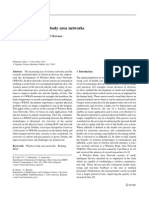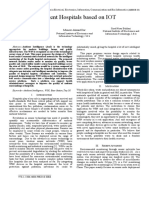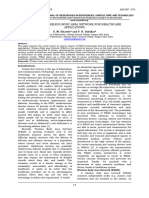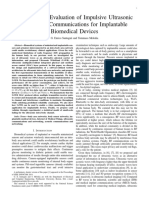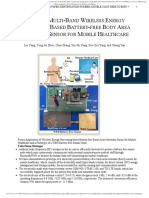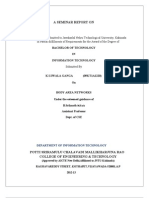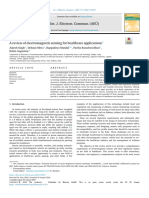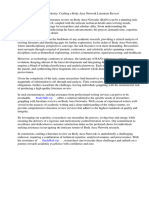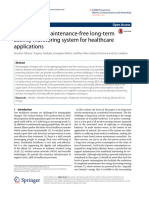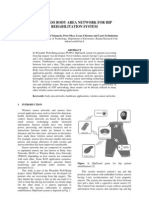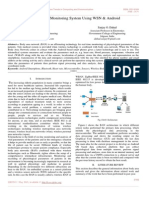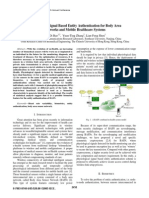0 ratings0% found this document useful (0 votes)
18 viewsWireless Sensor Networks in Biomedical: Body Area Networks Paul Honeine, Farah Mourad, Maya Kallas, Hichem Snoussi, Hassan Amoud, Clovis Francis
Wireless Sensor Networks in Biomedical: Body Area Networks Paul Honeine, Farah Mourad, Maya Kallas, Hichem Snoussi, Hassan Amoud, Clovis Francis
Uploaded by
dzungtheThis document discusses wireless sensor networks for biomedical applications called Body Area Networks (BANs). BANs are composed of tiny biomedical sensor nodes that collect vital body signs and wirelessly transmit the data. The document compares BANs to wireless sensor networks (WSNs) and discusses some of the unique challenges of BANs, including limited number of nodes, need for accurate measurements, and difficulty replacing implanted nodes. It also discusses energy consumption and heat absorption as important issues for BANs given nodes are close to or inside the human body.
Copyright:
© All Rights Reserved
Available Formats
Download as PDF, TXT or read online from Scribd
Wireless Sensor Networks in Biomedical: Body Area Networks Paul Honeine, Farah Mourad, Maya Kallas, Hichem Snoussi, Hassan Amoud, Clovis Francis
Wireless Sensor Networks in Biomedical: Body Area Networks Paul Honeine, Farah Mourad, Maya Kallas, Hichem Snoussi, Hassan Amoud, Clovis Francis
Uploaded by
dzungthe0 ratings0% found this document useful (0 votes)
18 views4 pagesThis document discusses wireless sensor networks for biomedical applications called Body Area Networks (BANs). BANs are composed of tiny biomedical sensor nodes that collect vital body signs and wirelessly transmit the data. The document compares BANs to wireless sensor networks (WSNs) and discusses some of the unique challenges of BANs, including limited number of nodes, need for accurate measurements, and difficulty replacing implanted nodes. It also discusses energy consumption and heat absorption as important issues for BANs given nodes are close to or inside the human body.
Original Description:
Kỹ thuật y sinh
Original Title
11.wosspa
Copyright
© © All Rights Reserved
Available Formats
PDF, TXT or read online from Scribd
Share this document
Did you find this document useful?
Is this content inappropriate?
This document discusses wireless sensor networks for biomedical applications called Body Area Networks (BANs). BANs are composed of tiny biomedical sensor nodes that collect vital body signs and wirelessly transmit the data. The document compares BANs to wireless sensor networks (WSNs) and discusses some of the unique challenges of BANs, including limited number of nodes, need for accurate measurements, and difficulty replacing implanted nodes. It also discusses energy consumption and heat absorption as important issues for BANs given nodes are close to or inside the human body.
Copyright:
© All Rights Reserved
Available Formats
Download as PDF, TXT or read online from Scribd
Download as pdf or txt
0 ratings0% found this document useful (0 votes)
18 views4 pagesWireless Sensor Networks in Biomedical: Body Area Networks Paul Honeine, Farah Mourad, Maya Kallas, Hichem Snoussi, Hassan Amoud, Clovis Francis
Wireless Sensor Networks in Biomedical: Body Area Networks Paul Honeine, Farah Mourad, Maya Kallas, Hichem Snoussi, Hassan Amoud, Clovis Francis
Uploaded by
dzungtheThis document discusses wireless sensor networks for biomedical applications called Body Area Networks (BANs). BANs are composed of tiny biomedical sensor nodes that collect vital body signs and wirelessly transmit the data. The document compares BANs to wireless sensor networks (WSNs) and discusses some of the unique challenges of BANs, including limited number of nodes, need for accurate measurements, and difficulty replacing implanted nodes. It also discusses energy consumption and heat absorption as important issues for BANs given nodes are close to or inside the human body.
Copyright:
© All Rights Reserved
Available Formats
Download as PDF, TXT or read online from Scribd
Download as pdf or txt
You are on page 1of 4
WIRELESS SENSOR NETWORKS IN BIOMEDICAL:
BODY AREA NETWORKS
Paul Honeine
(1)
, Farah Mourad
(1)
, Maya Kallas
(1,2)
, Hichem Snoussi
(1)
, Hassan Amoud
(3)
, Clovis Francis
(2)
(1)
Institut Charles Delaunay (CNRS), LM2S, Universit e de Technologie de Troyes, France
(2)
Laboratoire danalyse des syst` emes (LASYS), Universit e Libanaise, Lebanon
(3)
Azm Center for Research in Biotechnology and its Applications, Lebanese University, Lebanon
ABSTRACT
The rapid growth in biomedical sensors, low-power circuits
and wireless communications has enabled a new generation
of wireless sensor networks: the body area networks. These
networks are composed of tiny, cheap and low-power biomed-
ical nodes, mainly dedicated for healthcare monitoring ap-
plications. The objective of these applications is to ensure a
continuous monitoring of vital parameters of patients, while
giving them the freedom of motion and thereby better qual-
ity of healthcare. This paper shows a comparison of body
area networks to the wireless sensor networks. In particular,
it shows how body area networks borrow and enhance ideas
from wireless sensor networks. A study of energy consump-
tion and heat absorption problems is developed for illustra-
tion.
1. INTRODUCTION
Nowadays, biomedical sensors are used solely in health mon-
itoring applications, as with the electrocardiograms. In other
words, they are not yet integrated into communicating net-
works. However, with the increase of the vital body signs to
be monitored simultaneously, many biomedical sensors need
to work together to collect measurements at the same time.
Moreover, it is often important to communicate the measured
data from a sensing device to others. Thus, it becomes cru-
cial to have a network of communicating biomedical sensors.
This would have a radical impact on the quality of life of pa-
tients and on their treatment success rates. It could have a
wide range of future applications, as well, such as monitoring
of cardiovascular diseases, diabetes and asthma, consulting
cases via telemedicine or health-care systems, etc.
The Body Area Networks (BANs) have recently emerged
as a by-product to do so. They are a new generation of
Wireless Sensor Networks (WSNs), suited to monitor human
bodies. A BAN is composed of a collection of tiny nodes,
equipped with biomedical sensors, motion detectors and wire-
less communication devices. These nodes collect vital body
This work was partly supported by the Franco-Lebanese CEDRE program.
signs and then transmit them in a wireless manner to a cen-
tral unit where all collected information is processed. Due to
their wireless nature, BAN nodes have many advantages, such
as omnipresence connectivity, mobility and inter-operability
[1]. Some nodes may also be equipped with actuators, such
as pacemakers or instruments to store and inject medicines.
In this paper, we review some issues in BANs. We show
how BAN borrows and enhances ideas from the WSN litera-
ture. More specically, we study the energy consumption and
the heat absorption problems, both problems being tightly re-
lated.
2. FROM WSN TO BAN
2.1. Wireless sensor networks
Recent advances in miniaturization and wireless communi-
cation have enabled a new class of tiny powerful computers:
Wireless Sensor Networks (WSNs). WSNs consist of large-
scale, highly distributed and self-organized networks, mainly
developed for surveillance and monitoring. They are com-
posed of a large number of tiny and cheap nodes, having com-
puting, sensing and communication capabilities. WSNs were
initially meant for military applications such as large battle-
eld surveillance. In these applications, WSNs were assumed
to have cubic-millimeter computers, called smart dust [2]. To
the best of our knowledge, the smart dust concept has not
been realized. However, the issues and challenges of WSNs
pave the way to many new opportunities. It is thus expected
to use WSNs in a broad range of applications, including envi-
ronmental monitoring, animal migration monitoring, security
surveillance, industrial control, as well as personal healthcare
monitoring, etc.
2.2. Description of body area networks
The technology behind the WSNs is still under development.
However, the research on WSNs does not deal with the chal-
lenges associated with human body
1
monitoring. For this rea-
son, a new generation of WSNs has emerged: the Body Area
1
Body area networks are not limited to humans.
Table 1. Some differences between WSNs and BANs.
Wireless Sensor Networks Body Area Networks
Scale Wide area coverage (up to several kilometers) Limited by the human body (in centimeters)
Node number Huge number of nodes for coverage Limited number of pervasive nodes
Accuracy Compensated by the redundancy Accurate measurements are required by each node
Failure Nodes often disposable Difcult replacement of implanted nodes
Energy scavenging Solar or wind power Motion or body heat
Networks
2
(BANs). BANs provide a new paradigm for the
WSNs technology in the physiological biosensor, the MAC
layer, the network layer, the routing strategy, etc. Although
WSNs and BANs share many difculties, such as miniatur-
ization, they face different challenges, as shown in Table 1
[3].
A BAN is a network of wearable on-body computing de-
vices. It can also includes in vivo implanted biosensor de-
vices. According to the IEEE 802.15 (Task Group 6), a BAN
consists of low power devices operating on, in or around
the human body (but not limited to humans) to serve a va-
riety of applications including medical, consumer electronics
/ personal entertainment and other. BANs have a wide range
of applications, as, for instance, in gaming or virtual reality.
However, the main challenges in terms of research or engi-
neering remain in the biomedical and healthcare monitoring
applications. Indeed, evolution of BANs should follow the
ever-increasing development in the medical domain; its main
objective being to ensure constant vigilant and pervasive mon-
itoring of patients at home or at work.
2.3. Requirements in body area networks
Although BANs are essentially WSNs, they take the WSNs
to their extreme in many directions. Indeed, BANs for in-
stance are limited to the human body where very few nodes
are deployed. Having few sensing devices, data loss in BANs
could be signicant, as opposed to WSNs, where nodes yield
redundant information. Therefore, each node needs to pro-
vide accurate measurements, especially for nodes giving vi-
tal information, such as electrocardiogram (ECG) measure-
ments. This may require additional measurements to ensure
quality-of-service and real-time data delivery, since reliability
of measurements is a must in the medical domain. Moreover,
BANs often consist of networks with devices performing di-
verse tasks. Examples of these devices include ECG, blood
pressure, pulse oximetry, temperature, respiratory, etc. Such
heterogeneous characteristics require different frequency ac-
quisition rates as well as different transmission rates.
On the other hand, some devices of the BAN need to be
implanted, in vivo, inside the human body. Implanted biosen-
sors should be biocompatible, robust, as replacement is dif-
2
BANs are also known as wireless body area networks, or body sensor
networks.
cult, and with low energy requirements, since energy is hard
to supply. In addition, in BAN, nodes are in close proximity
to or inside the human body. This may lead to high absorption
of the electromagnetic radio-frequency waves, and thus to an
increase of the body temperature. According to the safety
limits for exposure to radio-frequency energy, communica-
tions should be uniformly distributed among all the nodes.
Moreover, as the human body is not rigid, frequent changes
in nodes positions should be considered in the network topol-
ogy. For these reasons, a special attention should be paid to
the design of the BAN, including the routing strategy.
3. ENERGY SCAVENGING
The energy consumption in BANs is crucial, especially in im-
planted biosensors, since they are inaccessible and difcult to
replace. For instance, a pacemaker battery usually lasts for 5
to 10 years. Since the battery is sealed inside the pacemaker,
replacing the battery leads to the replacement of the entire
system. In order to increase the lifetime of battery-powered
devices, extra amount of energy can be delivered by energy
harvesting, i.e., energy scavenging [4]. As opposed to WSNs,
where a great attention is paid to solar energy, BANs intro-
duced a new nature of energy scavenging. Devices can scav-
enge power from the human body using body heat and body
vibrations. Although heat and motion of the human body
bring new opportunities, they also introduce new challenges,
as shown in the following.
3.1. Body motion
Electrical power can be generated from motion and vibration,
with the so-called inertial-power scavenging. Natural human
body motion may be easily converted into electrical power.
This is illustrated by electronic self-winding watches based
on moving mechanics, such as the ETA Autoquartz and the
Seiko Automatic Generating System. More promising ap-
proaches are based on piezoelectric or capacitive generators.
An example of electric power generators is the electric shoes
[5, 6]. For instance, authors of [5] propose electric shoes to
provide autonomy to articial organs.
While motion may provide power to BANs, it introduces
new challenges. In fact, as the human body is not rigid, thus
the devices can move, at least relatively to each others. Thus,
frequent changes in the network topology should be consid-
ered in the design of the network architecture. BANs should
be robust to these changes, for instance by adapting the rout-
ing strategy, and the self-organization of the nodes.
3.2. Body heat
Temperature difference can be directly converted into elec-
trical power, as given by the Peltier-Seebeck effect. As any
heat engine, the efciency of thermoelectric energy is limited
by the Carnots theorem. In practice, large thermal gradients
are required to create satisfactory levels of voltage and power.
This limits the application of thermoelectric energy in BANs,
provided by body heat over ambient temperature. Neverthe-
less, recent works are very encouraging [7], as illustrated by
the Seiko Thermic watch.
While environment temperature cannot be controlled, hu-
man body temperature is essentially
3
37
C (98.6
F). In
BANs, the temperature is likely to be different than this com-
mon value. In fact, radio-frequency transmission of wireless
nodes located on-body or implanted contribute to radiation
absorption, which may result into thermal effects. For safety
reasons, the radiation absorption should be reduced, by con-
trolling the Specic Absorption Rate (SAR) [8] and using an
appropriate routing protocol (see Section 4.2).
4. ROUTING INFORMATION: FROM WSN TO BAN
In this section, the routing problem in BANs is tackled with
techniques fromthe WSNs literature. Our aim is to show how
BANs borrow and enhance ideas from WSNs. Three direc-
tions are presented here, with essentially the same goal: re-
ducing the absorption of power in the human body, which is
dissipated as heat. Such a problem is addressed by a cluster-
based routing, a temperature-aware routing, and using an on-
body node for implanted networks.
4.1. Routing by clustering
In WSNs, several properties for routing strategies are desir-
able: maximize system lifetime by uniform battery usage of
nodes, and application to large-scale networks. Such proper-
ties are not satised by classical network protocols, including
the direct transmission, multi-hop, and clustering.
The LEACH (Low Energy Adaptive Clustering Hierar-
chy) [9] strategy fullls the desired properties by combin-
ing, on the one hand a hierarchical protocol with clusterhead
nodes to aggregate and compress the data, and on the other
hand a randomized rotation of the clusterhead nodes. In fact,
a cluster-based hierarchy allows small communication dis-
tances for most nodes, the non-clusterhead nodes [10]. As
opposed to conventional clustering strategies, LEACH uses
3
Body temperature depends upon the place at which the measurement is
made (slightly higher when taken internally), and uctuates over the day.
rotating election of clusterhead nodes and adapting the cor-
responding clusters, which allows the energy requirements to
be uniformly distributed among all the senors. Moreover, data
is compressed at each clusterhead node, accomplishing an ad-
ditional reduction in the energy dissipation.
Several algorithms were derived for BAN based on
LEACH, using a node clustering structure. For instance, the
authors of [11] focus on the self-organization of nodes, as
opposed to the randomness election in LEACH which may
lead to some isolated nodes. In [12], the authors combine, on
the one hand clustering to reduce the number of long direct
communications, and on the other hand parallel, multi-hop
indirect transmissions, the co-called chains. Such combina-
tion has signicantly better energy efciency than LEACH,
as illustrated in [13] for in-body biomedical sensor networks.
It is worth noting that LEACH is optimized for large-scale
networks, which is not the case for BAN.
4.2. Temperature-aware routing
The Specic Absorption Rate (SAR) is dened as power ab-
sorbed per unit mass of the tissue, a measure in determining
the amount of power lost due to heat dissipation. In BAN, the
SAR should be taken into account, either locally or globally
using its average over the entire mass of tissue between the
transmitter and the receiver. Because of the SAR considera-
tion, the thermal effects of BAN should be considered in the
routing protocol. This can be done by balancing the commu-
nication over the nodes, as illustrated above with the LEACH
algorithm. Moreover, one may also consider the temperature
to select appropriate routing paths.
Temperature-aware routing was initially investigated in
[14], by rotating clusterhead nodes based on leadership his-
tory and node location. In [15], an (adaptive) least tempera-
ture routing is proposed by routing data away from high tem-
perature spots and area. To this end, multi-hop routing is ap-
plied, where each node selects its neighboring node with the
lowest temperature as its next hop. By selecting the next hop,
such approach is not optimized globally. To overcome this
drawback, one may consider the least total temperature route,
by including the shortest path routing. In [16], node temper-
ature is converted into graph weights and minimum tempera-
ture route is obtained using Dijkstras algorithm.
4.3. Routing: in vivo implanted networks
More constraints are imposed by in vivo implanted sensor net-
works, including restrictions due to absorption of communi-
cation power in the tissue (SAR), which is dissipated as heat.
For this reason, classical air-as-medium propagation models,
where losses are due to freespace wave propagation and mul-
tipath fading, are no longer appropriate. In the human body,
the saline-water nature of the human tissues contributes con-
siderably to the absorption of the electromagnetic waves in
communication. There has been considerable research going
on in the eld of measurement of calculation of SAR in hu-
man tissues, and specication of safe absorption rates [17].
It is well known that the in-body propagation loss is much
more than that of on-body propagation. Thus, routing data
among implanted nodes may be inappropriate for long range
communications. In [18], a new network architecture is pro-
posed for the implanted networks by introducing an on-body
coordinator. The coordinator plays the role of a beacon, by
forwarding the data from one implanted node to another over
long distance more safely and efciently. Since a coordina-
tor is on-body, it may include other functionalities, such as
monitoring and more power resources.
5. FINAL REMARKS
In this paper, our aim was to show how BAN and WSN are
intimately connected, borrowing and enhancing ideas from
each others. This was illustrated on the routing problem,
where BAN incorporates additional constraints including en-
ergy consumption, SAR and temperature considerations. All
these constraints are intimately connected. It is obvious that
this paper is not a survey on BAN. For instance, the physio-
logical biosensors and the MAC layer were not studied, nor
security issues [19, 20]. We refer the interested reader to more
comprehensive surveys [21, 22, 23]. It is worth noting that
most of these surveys were published in 2011, subsequent to
the initial submission of this work.
6. REFERENCES
[1] D. Cypher, N. Chevrollier, N. Montavont, and N. Golmie, Prevailing
over wires in healthcare environments: benets and challenges, IEEE
Communications Magazine, vol. 44, no. 4, pp. 5663, 2006.
[2] B. Warneke, K. S. J, and S. Dust, Smart dust: Communicating with a
cubic-millimeter computer, Classical Papers on Computational Logic,
vol. 1, pp. 372383, 2001.
[3] G.-Z. Yang, Body Sensor Networks. Secaucus, NJ, USA: Springer-
Verlag New York, Inc., 2006.
[4] J. A. Paradiso and T. Starner, Energy scavenging for mobile and wire-
less electronics, Pervasive Computing, IEEE, vol. 4, no. 1, pp. 1827,
Mar. 2005.
[5] J. F. Antaki, G. E. Bertocci, E. C. Green, A. Nadeem, T. Rintoul, R. L.
Kormos, and B. P. Grifth, A gait-powered autologous battery charg-
ing system for articial organs. ASAIO J., vol. 41, no. 3, pp. M58895,
1995.
[6] N. S. Shenck and J. A. Paradiso, Energy scavenging with shoe-
mounted piezoelectrics, IEEE Micro, vol. 21, pp. 3042, May 2001.
[7] J. W. Stevens, Optimal design of small T thermoelectric generation
systems, Energy Conversion and Management, vol. 42, pp. 709720,
2001.
[8] H. Ren and M. Meng, Rate control to reduce bioeffects in wireless
biomedical sensor networks, in Mobile and Ubiquitous Systems, An-
nual International Conference on. Los Alamitos, CA, USA: IEEE
Computer Society, July 2006, pp. 17.
[9] W. R. Heinzelman, A. Chandrakasan, and H. Balakrishnan, Energy-
efcient communication protocol for wireless microsensor networks,
in Proceedings of the 33rd Hawaii International Conference on System
Sciences-Volume 8 - Volume 8, ser. HICSS 00. Washington, DC,
USA: IEEE Computer Society, 2000.
[10] O. Younis, M. Krunz, and S. Ramasubramanian, Node clustering in
wireless sensor networks: Recent developments and deployment chal-
lenges, IEEE Network Magazine, vol. 20, pp. 2025, 2006.
[11] T. Watteyne, I. Aug e-Blum, M. Dohler, and D. Barthel, Anybody: a
self-organization protocol for body area networks, in Proceedings of
the ICST 2nd international conference on Body area networks, ser. Bo-
dyNets 07. ICST, Brussels, Belgium, Belgium: Institute for Com-
puter Sciences, Social-Informatics and Telecommunications Engineer-
ing, 2007, pp. 6:16:7.
[12] B. J. Culpepper, L. Dung, and M. Moh, Design and analysis of hybrid
indirect transmissions (hit) for data gathering in wireless micro sensor
networks, SIGMOBILE Mob. Comput. Commun. Rev., vol. 8, pp. 61
83, January 2004.
[13] M. Moh, B. Culpepper, L. Dung, T.-S. Moh, T. Hamada, and C.-F. Su,
On data gathering protocols for in-body biomedical sensor networks,
in IEEE Global Telecommunications Conference (GLOBECOM05),
St. Louis, MO, USA, Dec. 2005.
[14] Q. Tang, N. Tummala, E. K. S. Gupta, L. Schwiebert, S. Member, and
S. Member, Communication scheduling to minimize thermal effects
of implanted biosensor networks in homogeneous tissue, IEEE Tran.
Biomedical Eng, vol. 52, pp. 12851294, 2005.
[15] A. Bag and M. Bassiouni, Energy efcient thermal aware routing algo-
rithms for embedded biomedical sensor networks, IEEE International
Conference on Mobile Adhoc and Sensor Systems Conference, vol. 0,
pp. 604609, 2006.
[16] D. Takahashi, Y. Xiao, F. Hu, J. Chen, and Y. Sun, Temperature-aware
routing for telemedicine applications in embedded biomedical sensor
networks, EURASIP J. Wirel. Commun. Netw., vol. 2008, pp. 26:1
26:26, January 2008.
[17] A practical guide to the determination of human exposure to radiofre-
quency elds, NCRP, Tech. Rep. 119, 1993.
[18] B. Zhen, K. Takizawa, T. Aoyagi, and R. Kohno, A body surface coor-
dinator for implanted biosensor networks, in Proceedings of the 2009
IEEE international conference on Communications, ser. ICC09. Pis-
cataway, NJ, USA: IEEE Press, 2009, pp. 475479.
[19] E. Stuart, M. Moh, and T.-S. Moh, Privacy and security in biomed-
ical applications of wireless sensor networks, in First International
Symposium on Applied Sciences on Biomedical and Communication
Technologies ISABEL 08, Aalborg, Oct. 2008, pp. 15.
[20] L. W. Hanlen, D. Smith, J. A. Zhang, and D. Lewis, Key-sharing via
channel randomness in narrowband body area networks: is everyday
movement sufcient? in Proceedings of the Fourth International Con-
ference on Body Area Networks, ser. BodyNets 09. Brussels, Bel-
gium, Belgium: Institute for Computer Sciences, Social-Informatics
and Telecommunications Engineering, 2009, pp. 17:117:6.
[21] S. Ullah, H. Higgins, B. Braem, B. Latre, C. Blondia, I. Moerman,
S. Saleem, Z. Rahman, and K. Kwak, A comprehensive survey of
wireless body area networks, Journal of Medical Systems, pp. 130,
Aug. 2010.
[22] M. Chen, S. Gonzalez, A. Vasilakos, H. Cao, and V. Leung, Body area
networks: A survey, Mobile Networks and Applications, vol. 16, no. 2,
pp. 171193, 2011.
[23] B. Latr e, B. Braem, I. Moerman, C. Blondia, and P. Demeester, A
survey on wireless body area networks, Wireless Networks, vol. 17,
pp. 118, January 2011.
You might also like
- Cosme Activity 2.2 Parts of NailDocument3 pagesCosme Activity 2.2 Parts of NailLigaya PastorNo ratings yet
- 11.wosspa 2Document4 pages11.wosspa 2akttripathiNo ratings yet
- 1-195 Cse PDFDocument195 pages1-195 Cse PDFRAJESH SLNo ratings yet
- Full TextDocument18 pagesFull Textek9925No ratings yet
- Health Monitoring SystemDocument8 pagesHealth Monitoring SystemElizabeth HarrisNo ratings yet
- Power Harvesting, Dynamic and Reliable Green Wireless Body Area Networks For Health Care ApplicationsDocument4 pagesPower Harvesting, Dynamic and Reliable Green Wireless Body Area Networks For Health Care ApplicationsChrys StinsonNo ratings yet
- Review Optimization Algorithms in Wireless Body ArDocument19 pagesReview Optimization Algorithms in Wireless Body Arumamahesh nitrklNo ratings yet
- A Review of Wireless Body Area NetworkDocument6 pagesA Review of Wireless Body Area NetworkEditor IJTSRDNo ratings yet
- Review Article: Wireless Body Area Networks For Healthcare Applications: Protocol Stack ReviewDocument24 pagesReview Article: Wireless Body Area Networks For Healthcare Applications: Protocol Stack ReviewMargarita CuellarNo ratings yet
- Wireless Body Area NetworkDocument7 pagesWireless Body Area NetworkPrajwalNo ratings yet
- Review On Medical Sensors For Health Care Monitoring Systems - EditedDocument16 pagesReview On Medical Sensors For Health Care Monitoring Systems - EditedSrilekha mkNo ratings yet
- Continuous Health-Monitoring For Early Detection of Patient by Web Telemedicine SystemDocument8 pagesContinuous Health-Monitoring For Early Detection of Patient by Web Telemedicine SystemAmali JayawardhanaNo ratings yet
- Wireless Body Area NetworkDocument18 pagesWireless Body Area Network108databox100% (1)
- A Comprehensive SurveyDocument30 pagesA Comprehensive Surveyayesha2728No ratings yet
- Wireless Body Area Networks: A SurveyDocument29 pagesWireless Body Area Networks: A Surveyabdul hananNo ratings yet
- A Review Paper On Wireless Body Area Network For Health Care ApplicationsDocument11 pagesA Review Paper On Wireless Body Area Network For Health Care ApplicationskishanNo ratings yet
- Final Year Project Proposal: Project Title: Early Warning and Health Monitoring System Using Wireless Sensor NetworksDocument7 pagesFinal Year Project Proposal: Project Title: Early Warning and Health Monitoring System Using Wireless Sensor NetworksMaryam BabarNo ratings yet
- CBM370Document16 pagesCBM370malathid06112No ratings yet
- Survivable and Scalable Wireless Solution For E-Health and E-Emergency ApplicationsDocument5 pagesSurvivable and Scalable Wireless Solution For E-Health and E-Emergency ApplicationskeerthiNo ratings yet
- Intelligent Hospitals Based On IOTDocument3 pagesIntelligent Hospitals Based On IOTgopinathNo ratings yet
- A Comprehensive Survey of Wireless Body Area NetwoDocument19 pagesA Comprehensive Survey of Wireless Body Area Netwohansley cookNo ratings yet
- Researchpaper Super Capacitor Based Energy Harvesting System For Wireless Sensor NodeDocument15 pagesResearchpaper Super Capacitor Based Energy Harvesting System For Wireless Sensor NodeSumaya ShinosNo ratings yet
- Module 4 NotesDocument17 pagesModule 4 Notesmengani.ramesh198No ratings yet
- Human Body Area Networks: Dr. P. Bhaskara Reddy, G. Prabhakara Reddy, V. Koti ReddyDocument8 pagesHuman Body Area Networks: Dr. P. Bhaskara Reddy, G. Prabhakara Reddy, V. Koti ReddyArnav GudduNo ratings yet
- Body Area Network: Presentation By: Muhammed Nigil K A S8 CseDocument19 pagesBody Area Network: Presentation By: Muhammed Nigil K A S8 CseArjun RajNo ratings yet
- Body Area NetworkDocument6 pagesBody Area NetworkЗоран ПавловићNo ratings yet
- Advances in Antenna-Based Techniques For Detection and Monitoring of Critical Chronic Diseases A Comprehensive ReviewDocument22 pagesAdvances in Antenna-Based Techniques For Detection and Monitoring of Critical Chronic Diseases A Comprehensive ReviewbcruchithaNo ratings yet
- A WBAN System For Ambulatory Monitoring of Physical Activity and Health Status: Applications and ChallengesDocument4 pagesA WBAN System For Ambulatory Monitoring of Physical Activity and Health Status: Applications and ChallengesayobaqmibabsNo ratings yet
- ARTICLE 22Document11 pagesARTICLE 22muddanapadmapriyaNo ratings yet
- Survey On Wireless Body Area Network For Healthcare ApplicationsDocument4 pagesSurvey On Wireless Body Area Network For Healthcare Applicationstanya RankawatNo ratings yet
- An Efficient Cross-Layer Reliable Retransmission Scheme For The Human Body Shadowing in IEEE 802.15.6-Based Wireless Body Area NetworksDocument11 pagesAn Efficient Cross-Layer Reliable Retransmission Scheme For The Human Body Shadowing in IEEE 802.15.6-Based Wireless Body Area NetworksTabassumWaheedNo ratings yet
- Experimental Evaluation of Impulsive Ultrasonic Intra-Body Communications For Implantable Biomedical DevicesDocument14 pagesExperimental Evaluation of Impulsive Ultrasonic Intra-Body Communications For Implantable Biomedical DevicesGeneration GenerationNo ratings yet
- Real Time Health Monitoring For Palliative Patients Through MSE WBAN ArchitectureDocument16 pagesReal Time Health Monitoring For Palliative Patients Through MSE WBAN ArchitectureAthenaeum Scientific PublishersNo ratings yet
- A Self-Adaptive Sleep Wake-Up SchedulingDocument82 pagesA Self-Adaptive Sleep Wake-Up SchedulingAsha SumithaNo ratings yet
- Security Issues in Healthcare Applications Using Wireless Medical Sensor Networks: A SurveyDocument7 pagesSecurity Issues in Healthcare Applications Using Wireless Medical Sensor Networks: A SurveyKrishnan T.G.B.No ratings yet
- PAPER - 2 (Compat Multiband Wireless Energy Harvesting)Document8 pagesPAPER - 2 (Compat Multiband Wireless Energy Harvesting)Adarsh SrivatsaNo ratings yet
- Body Area NetworksDocument10 pagesBody Area NetworksUjwala GangaNo ratings yet
- 1 s2.0 S1434841123003473 MainDocument15 pages1 s2.0 S1434841123003473 Mainmed BoutaaNo ratings yet
- Seminar ReportDocument21 pagesSeminar ReportIvinNo ratings yet
- A Survey of Challenges and Applications of Wireless Body Area Network (WBAN) and Role of A Virtual Doctor Server in Existing Architecture PDFDocument6 pagesA Survey of Challenges and Applications of Wireless Body Area Network (WBAN) and Role of A Virtual Doctor Server in Existing Architecture PDFMichael Enrique IntriagoNo ratings yet
- Antennas For Healthcare and Imaging: Case Study-1Document3 pagesAntennas For Healthcare and Imaging: Case Study-1sindhuraNo ratings yet
- UNIT IIIDocument41 pagesUNIT IIIckparul001No ratings yet
- A Versatile Biomedical Wireless Sensor Node With Novel Drysurface Sensors and Energy Efficient Power ManagementDocument7 pagesA Versatile Biomedical Wireless Sensor Node With Novel Drysurface Sensors and Energy Efficient Power Managementghadeer alkhodrNo ratings yet
- Performance Evaluation of Healthcare Monitoring System Over Heterogeneous Wireless NetworksDocument10 pagesPerformance Evaluation of Healthcare Monitoring System Over Heterogeneous Wireless NetworksRanjit KumarNo ratings yet
- UNIT IIDocument31 pagesUNIT IIckparul001No ratings yet
- Other SectionsDocument11 pagesOther SectionsmmusfirNo ratings yet
- Wireless Body Area Network (WBAN) : A Survey On Architecture, Technologies, Energy Consumption, and Security ChallengesDocument34 pagesWireless Body Area Network (WBAN) : A Survey On Architecture, Technologies, Energy Consumption, and Security ChallengesNischal KataraNo ratings yet
- Body Area Network Literature ReviewDocument8 pagesBody Area Network Literature Reviewc5nr2r46100% (1)
- 1 s2.0 S0140366406000508 Main PDFDocument13 pages1 s2.0 S0140366406000508 Main PDFBrianAQsumaNo ratings yet
- A Review On Wireless Body Area Network (WBAN) For Health Monitoring System: Implementation ProtocolsDocument6 pagesA Review On Wireless Body Area Network (WBAN) For Health Monitoring System: Implementation Protocolsvasile_silionNo ratings yet
- Neural Wireless Sensor Networks: Frank Oldewurtel and Petri M Ah OnenDocument8 pagesNeural Wireless Sensor Networks: Frank Oldewurtel and Petri M Ah Onenmeet123chanaNo ratings yet
- ARTICLE 23Document5 pagesARTICLE 23muddanapadmapriyaNo ratings yet
- A Residential Maintenance-Free Long-Term Activity Monitoring System For Healthcare Applications - s13638-016-0534-3Document20 pagesA Residential Maintenance-Free Long-Term Activity Monitoring System For Healthcare Applications - s13638-016-0534-3Generation GenerationNo ratings yet
- Health Monitoring Using Wearable Computers: Ms P.V.Pradeepa, Ms. M. PallaviDocument4 pagesHealth Monitoring Using Wearable Computers: Ms P.V.Pradeepa, Ms. M. PallavierpublicationNo ratings yet
- Benyas Networking SeminarDocument11 pagesBenyas Networking Seminaranimawasirat3No ratings yet
- Article ID 290 Soini 290Document7 pagesArticle ID 290 Soini 290Ubiquitous Computing and Communication JournalNo ratings yet
- Smart Patient Monitoring System Using WSN & AndroidDocument6 pagesSmart Patient Monitoring System Using WSN & AndroidEditor IJRITCC0% (1)
- 2010-Wireless Sensor Network Based E-Health SystemDocument8 pages2010-Wireless Sensor Network Based E-Health Systemsm2nictNo ratings yet
- Physiological Signal Based Entity Authentication For Body Area Sensor Networks and Mobile Healthcare SystemsDocument4 pagesPhysiological Signal Based Entity Authentication For Body Area Sensor Networks and Mobile Healthcare SystemsjayaNo ratings yet
- Handbook of Ultra-Wideband Short-Range Sensing: Theory, Sensors, ApplicationsFrom EverandHandbook of Ultra-Wideband Short-Range Sensing: Theory, Sensors, ApplicationsNo ratings yet
- Physicochemical Analysis of Water From Various Sources and Their Comparative StudiesDocument5 pagesPhysicochemical Analysis of Water From Various Sources and Their Comparative Studieskirito kirigayaNo ratings yet
- Quiz 3Document10 pagesQuiz 3Shaukat Ali ShahNo ratings yet
- Prbelec AmendedDocument7 pagesPrbelec AmendedMewnEProwtNo ratings yet
- Maryland Emergency Medical System Operations Fund: Audit ReportDocument18 pagesMaryland Emergency Medical System Operations Fund: Audit ReportBella N.No ratings yet
- Balance of Payment in BDDocument7 pagesBalance of Payment in BDSaif ShakilNo ratings yet
- Will and Shall 2: Yes, She's A Good Driver. She'll Pass EasilyDocument2 pagesWill and Shall 2: Yes, She's A Good Driver. She'll Pass EasilyDanil PechorinNo ratings yet
- Arc'Teryx: Entries in ApparelDocument7 pagesArc'Teryx: Entries in ApparelFrankie HungNo ratings yet
- MS - K5 - Nutrition and Bone Health (Gizi)Document30 pagesMS - K5 - Nutrition and Bone Health (Gizi)Dominique MendozaNo ratings yet
- Functional Safety Certificate Fmeda Report 3051s Electronic Remote Sensors Ers System en 88458Document35 pagesFunctional Safety Certificate Fmeda Report 3051s Electronic Remote Sensors Ers System en 88458irinaNo ratings yet
- AssignmentDocument49 pagesAssignmentWeng Hoe CheahNo ratings yet
- Ihe Pub x210 Drive Replacement GuideDocument8 pagesIhe Pub x210 Drive Replacement GuideVicente JuniorNo ratings yet
- VA - Sankalp Parihar - 142Document13 pagesVA - Sankalp Parihar - 142Sankalp PariharNo ratings yet
- Sem III OLD-1Document119 pagesSem III OLD-1sanket0% (1)
- A: Economic and Business Cycles GDP Expenditure ApproachDocument57 pagesA: Economic and Business Cycles GDP Expenditure ApproachPavan LuckyNo ratings yet
- Contoh Tiket Citilink - Co.idDocument1 pageContoh Tiket Citilink - Co.idGovind SugandaNo ratings yet
- WR 0518 1 4 PDFDocument4 pagesWR 0518 1 4 PDFPauldingProgressNo ratings yet
- Get SmarterDocument8 pagesGet SmarterRaúl Tabarés GutiérrezNo ratings yet
- EIP4CCPU EthernetIP Quick Start GuideDocument29 pagesEIP4CCPU EthernetIP Quick Start GuidenerkoNo ratings yet
- San Diego Quick Assessment 3Document3 pagesSan Diego Quick Assessment 3Jean ANo ratings yet
- Experimental Studies On Heat Transfer and Pressure Drop Characteristics For New Arrangements of Corrugated Tubes in A Double Pipe Heat ExchangerDocument10 pagesExperimental Studies On Heat Transfer and Pressure Drop Characteristics For New Arrangements of Corrugated Tubes in A Double Pipe Heat ExchangerkumarNo ratings yet
- S.No Answer Options: 1 Choose The Correct Answer: If One Bird Has Two Claws, How Many Claws Do 4 Birds Have?Document3 pagesS.No Answer Options: 1 Choose The Correct Answer: If One Bird Has Two Claws, How Many Claws Do 4 Birds Have?Ashish DasNo ratings yet
- Mt6260a MediatekDocument94 pagesMt6260a MediatekAntony BurgersNo ratings yet
- Cfp5E/Cfp7E Series: Fire Pump Drive EnginesDocument152 pagesCfp5E/Cfp7E Series: Fire Pump Drive EnginesMiguel MartinezNo ratings yet
- Pragmatic Coders CASE STUDIESDocument37 pagesPragmatic Coders CASE STUDIESawais zubairNo ratings yet
- PMP Exam Content OutlineDocument19 pagesPMP Exam Content OutlineBoneyPhilipNo ratings yet
- Attitude Towards Choice Based Credit System of Graduate Level Students in Higher Education A Study On Government Degree College For Women Anantnag KashmirDocument5 pagesAttitude Towards Choice Based Credit System of Graduate Level Students in Higher Education A Study On Government Degree College For Women Anantnag KashmirbiswaranjansatpathyNo ratings yet
- jc400 ManualDocument70 pagesjc400 ManualMTB Road Gab (roadgab)No ratings yet
- 10000005551Document119 pages10000005551Chapter 11 DocketsNo ratings yet



